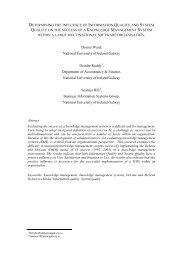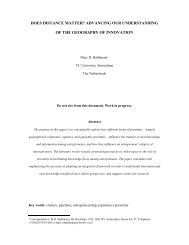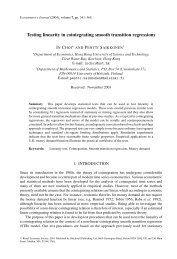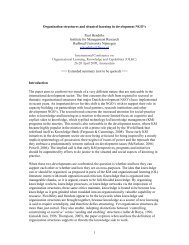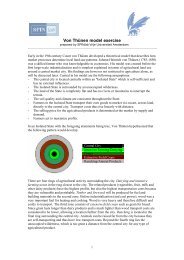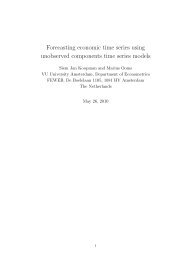Pinar Karaca-Mandic and Kenneth Train, (2003), pp. 400 ... - Feweb
Pinar Karaca-Mandic and Kenneth Train, (2003), pp. 400 ... - Feweb
Pinar Karaca-Mandic and Kenneth Train, (2003), pp. 400 ... - Feweb
You also want an ePaper? Increase the reach of your titles
YUMPU automatically turns print PDFs into web optimized ePapers that Google loves.
St<strong>and</strong>ard error correction in two-stage estimation with nested samples 401<br />
an omitted product attribute), then some form of instrumental variables estimation is needed to<br />
account for this correlation. The first stage specifies price as a function of instruments using<br />
market-level data, <strong>and</strong> the second stage utilizes the predicted price or the residual in estimation<br />
of the customer-level model.<br />
Kuksov <strong>and</strong> Villas-Boas (2001) derive a similar formula for a related set-up. Their samples<br />
are not nested; instead, each unit of observation in the second stage a<strong>pp</strong>ears repeatedly in all<br />
of the first-stage observations (i.e. each customer is observed in each of several time periods.)<br />
They allow correlation over first-stage observations in the unobservables associated with each<br />
second-stage unit (i.e. correlation for the same customer over time). In contrast, our formula uses<br />
independence over first-stage observations.<br />
We a<strong>pp</strong>ly our formula to the Petrin–<strong>Train</strong> a<strong>pp</strong>lication of households’ choice of TV reception.<br />
They are concerned that the prices of the TV reception alternatives are correlated with the<br />
unobserved attributes of the alternatives. To correct for this endogeneity, they specify a firststage<br />
linear regression of prices on exogenous variables <strong>and</strong> instrumental variables using market<br />
level data. The second stage is a mixed logit model. The dependent variable is the TV reception<br />
choice of a customer in a given market, <strong>and</strong> the independent variables are market level<br />
prices, market level residuals estimated in the first stage <strong>and</strong> other observed attributes of the<br />
alternatives.<br />
2. FRAMEWORK<br />
First stage. Estimated parameters ˆθ1 solve moment conditions ¯h( ˆθ1) = 0 where ¯h(θ1) =<br />
1<br />
N1<br />
<br />
m hm(θ1, zm), N1 is the number of observations, <strong>and</strong> hm(θ1; zm) is a vector of moments for<br />
observation m which depends on data zm.<br />
Second stage. Estimated parameters ˆθ2 solve moment conditions ¯g( ˆθ2, ˆθ1) = 0 where ¯g(θ2, ˆθ1)<br />
= 1 <br />
N2 n gn(θ2, ˆθ1; xn), N2 is the number of observations, <strong>and</strong> gn(θ2, ˆθ1; xn) is the moment for<br />
observation n based on its data <strong>and</strong> the first-stage estimates.<br />
Each n in the second stage corresponds to an m in the first stage (e.g. n indexes customers,<br />
m indexes markets, <strong>and</strong> each customer buys in one market). Therefore, there are one or more<br />
observations in the second-stage sample from each group in the first-stage sample. Also, xn in<br />
the second stage can include one or more elements of zm for the m corresponding to n.<br />
Take a Taylor expansion of both the first- <strong>and</strong> second-stage moment conditions around the<br />
true parameters θ ∗ 1 <strong>and</strong> θ ∗ 2 (assuming that the moment conditions are bounded <strong>and</strong> differentiable<br />
around the true parameters) <strong>and</strong> evaluate it asymptotically. For the first stage:<br />
<strong>and</strong> for the second stage:<br />
where<br />
c○ Royal Economic Society <strong>2003</strong><br />
0 a = ¯h(θ ∗ 1 ) − A( ˆθ1 − θ ∗ 1 ),<br />
0 a = ¯g(θ ∗ 2 , θ ∗ 1 ) − B( ˆθ1 − θ ∗ 1 ) − C( ˆθ2 − θ ∗ 2 ),<br />
A = −plim∇θ1 ¯h(θ ∗ 1 )<br />
B = −plim∇θ1 ¯g(θ ∗ 2 , θ ∗ 1 )<br />
C = −plim∇θ2 ¯g(θ ∗ 2 , θ ∗ 1 ),





